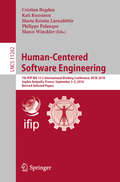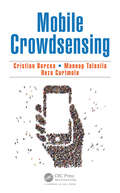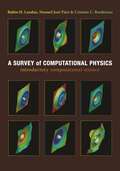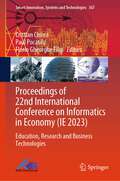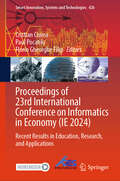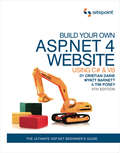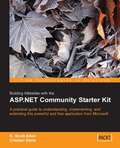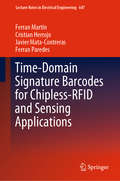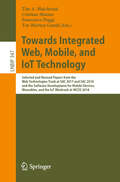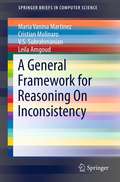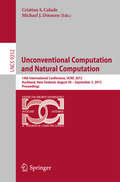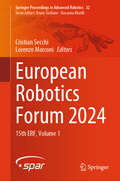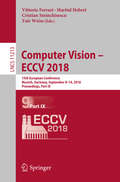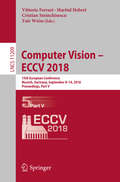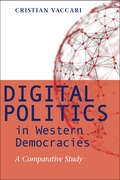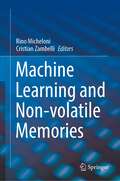- Table View
- List View
Human-Centered Software Engineering (Lecture Notes in Computer Science #8742)
by Cristian Bogdan Marco Winckler Philippe Palanque Kati Kuusinen Marta Kristín LárusdóttirThis book constitutes the refereed post-conference proceedings of the 7th IFIP WG 13.2 International Conference on Human-Centered Software Engineering, HCSE 2018, held in Sophia Antipolis, France, in September 2018. The 11 full papers and 7 short papers presented together with 5 poster and demo papers were carefully reviewed and selected from 36 submissions. The papers focus on the interdependencies between user interface properties and contribute to the development of theories, methods, tools and approaches for dealing with multiple properties that should be taken into account when developing interactive systems. They are organized in the following topical sections: HCI education and training; model-based and model-driven approaches; task modeling and task-based approaches; tools and tool support; and usability evaluation and UI testing.
Mobile Crowdsensing
by Cristian Borcea Manoop Talasila Reza CurtmolaMobile crowdsensing is a technology that allows large scale, cost-effective sensing of the physical world. In mobile crowdsensing, mobile personal devices such as smart phones or smart watches come equipped with a variety of sensors that can be leveraged to collect data related to environment, transportation, healthcare, safety and so on. This book presents the first extensive coverage of mobile crowdsensing, with examples and insights drawn from the authors’ extensive research on this topic as well as from the research and development of a growing community of researchers and practitioners working in this emerging field. Throughout the text, the authors provide the reader with various examples of crowdsensing applications and the building blocks to creating the necessary infrastructure, explore the related concepts of mobile sensing and crowdsourcing, and examine security and privacy issues introduced by mobile crowdsensing platforms. Provides a comprehensive description of mobile crowdsensing, a one-stop shop for all relevant issues pertaining to mobile crowdsensing, including motivation, applications, design and implementation, incentive mechanisms, and reliability and privacy. Describes the design and implementations of mobile crowdsensing platforms of great interest for the readers working in research and industry to quickly implement and test their systems. Identifies potential issues in building such mobile crowdsensing applications to ensure their usability in real life and presents future directions in mobile crowdsensing by emphasizing the open problems that have to be addressed.
A Survey of Computational Physics: Introductory Computational Science
by Cristian C. Bordeianu José Páez Rubin LandauComputational physics is a rapidly growing subfield of computational science, in large part because computers can solve previously intractable problems or simulate natural processes that do not have analytic solutions. The next step beyond Landau's First Course in Scientific Computing and a follow-up to Landau and Páez's Computational Physics, this text presents a broad survey of key topics in computational physics for advanced undergraduates and beginning graduate students, including new discussions of visualization tools, wavelet analysis, molecular dynamics, and computational fluid dynamics. By treating science, applied mathematics, and computer science together, the book reveals how this knowledge base can be applied to a wider range of real-world problems than computational physics texts normally address. Designed for a one- or two-semester course, A Survey of Computational Physics will also interest anyone who wants a reference on or practical experience in the basics of computational physics. Accessible to advanced undergraduates Real-world problem-solving approach Java codes and applets integrated with text Companion Web site includes videos of lectures
Computational Physics: Problem Solving with Python
by Cristian C. Bordeianu Rubin H. Landau Manuel J. PáezComputational Physics The classic in the field for more than 25 years, now with increased emphasis on data science and new chapters on quantum computing, machine learning (AI), and general relativity Computational physics combines physics, applied mathematics, and computer science in a cutting-edge multidisciplinary approach to solving realistic physical problems. It has become integral to modern physics research because of its capacity to bridge the gap between mathematical theory and real-world system behavior. Computational Physics provides the reader with the essential knowledge to understand computational tools and mathematical methods well enough to be successful. Its philosophy is rooted in “learning by doing”, assisted by many sample programs in the popular Python programming language. The first third of the book lays the fundamentals of scientific computing, including programming basics, stable algorithms for differentiation and integration, and matrix computing. The latter two-thirds of the textbook cover more advanced topics such linear and nonlinear differential equations, chaos and fractals, Fourier analysis, nonlinear dynamics, and finite difference and finite elements methods. A particular focus in on the applications of these methods for solving realistic physical problems. Readers of the fourth edition of Computational Physics will also find: An exceptionally broad range of topics, from simple matrix manipulations to intricate computations in nonlinear dynamicsA whole suite of supplementary material: Python programs, Jupyter notebooks and videos Computational Physics is ideal for students in physics, engineering, materials science, and any subjects drawing on applied physics.
Education, Research and Business Technologies: Proceedings of 20th International Conference on Informatics in Economy (IE 2021) (Smart Innovation, Systems and Technologies #276)
by Cristian Ciurea Paul Pocatilu Cătălin Boja Mihai DoineaThis book includes high-quality research papers presented at 20th International Conference on Informatics in Economy (IE 2021), which is held in Bucharest, Romania during May 2021. The book covers research results in business informatics and related computer science topics, such as IoT, mobile-embedded and multimedia solutions, e-society, enterprise and business solutions, databases and big data, artificial intelligence, data-mining and machine learning, quantitative economics.
Education, Research and Business Technologies: Proceedings of 21st International Conference on Informatics in Economy (IE 2022) (Smart Innovation, Systems and Technologies #321)
by Florin Gheorghe Filip Cristian Ciurea Paul PocatiluThis book includes high-quality research papers presented at 21st International Conference on Informatics in Economy (IE 2022), which is held in Bucharest, Romania, during May 2022. This book covers research results in business informatics and related computer science topics, such as IoT, mobile-embedded and multimedia solutions, e-society, enterprise and business solutions, databases and big data, artificial intelligence, data mining and machine learning, quantitative economics.
Proceedings of 22nd International Conference on Informatics in Economy: Education, Research and Business Technologies (Smart Innovation, Systems and Technologies #367)
by Florin Gheorghe Filip Cristian Ciurea Paul PocatiluThis book includes high-quality research papers presented at 22nd International Conference on Informatics in Economy (IE 2023), which is held in Bucharest, Romania, during May 2023. This book covers research results in business informatics and related computer science topics, such as IoT, mobile-embedded and multimedia solutions, e-society, enterprise and business solutions, databases and big data, artificial intelligence, data mining and machine learning, quantitative economics.
Proceedings of 23rd International Conference on Informatics in Economy: Recent Results in Education, Research, and Applications (Smart Innovation, Systems and Technologies #426)
by Florin Gheorghe Filip Cristian Ciurea Paul PocatiluThis book includes high-quality research papers presented at 23rd International Conference on Informatics in Economy (IE 2024), which is held in Bucharest, Romania, during May 2024. This book covers research results in business informatics and related computer science topics, such as IoT, mobile-embedded and multimedia solutions, e-society, enterprise and business solutions, databases and big data, artificial intelligence, data mining and machine learning, quantitative economics.
Build Your Own ASP.NET 4 Web Site Using C# & VB, 4th Edition: Using C# & VB
by Cristian Darie Timmothy Posey Wyatt BarnettBuild Your Own ASP.NET 4 Web Site Using C# & VB is aimed at beginner ASP.NET developers wanting to develop their skills, web designers wanting to move into server-side programming, and experienced developers making the leap from ASP to .NET.Readers will learn:language and programming basicshow to construct ASP.Net Web Pageshow to build web applicationsto use validation controlsdatabase design and developmenthow to use ADO.NEThow to manage data and contenthow to integrate Ajax and jQuerythe role of MVC... all in the process of successfully developing and deploying a working intranet site for a fictional company.
Building Websites with the ASP.NET Community Starter Kit
by Cristian Darie K. Scott AllenThis book isn't written as a standard tutorial, it has been broken down into two halves to give you full understanding of the Community Starter Kit and then the confidence to create, administer and customize your own site. The second half of the book includes plenty of code, but the emphasis is firmly on guiding you through the techniques to create, extend and customize your own module. This book has been written for ASP.NET developers with a sound grasp of C# and access to Visual Studio .NET. This book uses the Visual Studio. NET version of the ASP.NET Community Starter Kit.
Creating New Medical Ontologies for Image Annotation: A Case Study (SpringerBriefs in Electrical and Computer Engineering)
by Liana Stanescu Dumitru Dan Burdescu Marius Brezovan Cristian Gabriel MihaiCreating New Medical Ontologies for Image Annotation focuses on the problem of the medical images automatic annotation process, which is solved in an original manner by the authors. All the steps of this process are described in detail with algorithms, experiments and results. The original algorithms proposed by authors are compared with other efficient similar algorithms. In addition, the authors treat the problem of creating ontologies in an automatic way, starting from Medical Subject Headings (MESH). They have presented some efficient and relevant annotation models and also the basics of the annotation model used by the proposed system: Cross Media Relevance Models. Based on a text query the system will retrieve the images that contain objects described by the keywords.
Sim City Buildit Guía no oficial del juego
by Hiddenstuff Entertainment Cristian García HerreroCon mi Guía de Juego aprenderás exactamente lo que necesitas saner para convertirte en un jugador experto, ¡y conseguir montones de recursos para construir la ciudad definitiva! Esta es una guía completa con todo lo que debes saber acerca del juego. - Vista General e Información Básica. - Consejos Profesionales y Estrategias. - Cómo Conseguir Montones de Dinero. - Cómo Construir correctamente Tu Ciudad. - Instrucciones Detalladas y Fáciles. - Secretos, Consejos, Trampas, Desbloqueables, y ¡Trucos Usados Por Jugadores Pro! - ¡Y MUCHO MÁS! ¡Compra ahora y aplasta a tus enemigos! ¡Conviérte en un Jugador Pro hoy mismo! Advertencia: Este producto no está asociado, afiliado, promocionado, certificado, o patrocinado por EA Games. Esta guía ha de ser usada simplemente como referencia y como tal no modifica el juego en manera alguna. Esto es una guía escrita y no un programa de software.
Advances in Disordered Systems, Random Processes and Some Applications
by Pierluigi Contucci Cristian GiardinàThis book offers a unified perspective on the study of complex systems for scholars of various disciplines, including mathematics, physics, computer science, biology, economics and social science. The contributions, written by leading scientists, cover a broad set of topics, including new approaches to data science, the connection between scaling limits and conformal field theories, and new ideas on the Legendre duality approach in statistical mechanics of disordered systems. The volume moreover explores results on extreme values of correlated random variables and their connection with the Riemann zeta functions, the relation between diffusion phenomena and complex systems, and the Brownian web, which appears as the universal scaling limit of several probabilistic models. Written for researchers from a broad range of scientific fields, this text examines a selection of recent developments in complex systems from a rigorous perspective. Includes accounts of recent probabilistic methods used to investigate scaling limits from discrete to continuum models. Maths and physics are presented side by side in order to solve current open problems in disordered systems. Readers will be exposed to an up-to-date treatment of large databases, as well as to their theoretical modelisation.
Time-Domain Signature Barcodes for Chipless-RFID and Sensing Applications (Lecture Notes in Electrical Engineering #647)
by Ferran Martín Cristian Herrojo Javier Mata-Contreras Ferran ParedesThis book presents an unconventional approach for implementing chipless radiofrequency identification (RFID) systems and related sensors. Contrary to most state-of-the-art chipless-RFID systems, the proposed approach is based on time domain and the tags are read through near field. The book discusses different aspects of these chipless-RFID systems, including tag and reader design, strategies to enhance the data density and capacity, tag programming and erasing, tag implementation in plastic and paper substrates, and synchronous tag reading, among others. A tolerance analysis and validation of the different systems, as well as prospective applications, are also included. The book also offers a comprehensive overview of the state-of-the-art in chipless-RFID technology, including a comparative analysis, which is extended also to chip-based RFID systems. Readers are expected to be familiar with RF/microwave engineering technology. Besides master’s and postgraduate students, the book is intended for researchers in the field of radiofrequency identification (RFID) technology, and may be of interest for engineers working in the areas of wireless communications, automatic identification, security, authentication, microwave and wireless sensors, as well as those dealing with internet of things (IoT) and smart systems.
CATIA v5: Advanced Parametric and Hybrid 3D Design
by Saša Ćuković Ionuţ Gabriel Ghionea Cristian Ioan TarbăThis tutorial textbook is an essential companion to using CATIA v5 to assist with computer-aided design. Using clear CAD examples, it demonstrates the various ways through which the potential of this versatile software can be used to aid engineers in 3D modelling. Based on 20 years of teaching experience, the authors present methods of using CATIA v5 to model solid and surface parts, to perform parametric modelling and design of families of parts, reconstruction of surfaces, to create macros and to apply various tools and their options during 3D modelling. Importantly, this book will also help readers to discover multiple modelling solutions and approaches to solve common issues within design engineering. With a comprehensive approach, this book is suitable for both beginners and those with a good grasp of CATIA v5. Featuring an end chapter with questions and solutions for self-assessment, this book also includes 3D modelling practice problems, presented in the form of 2D engineering drawings of many 3D parts in both orthogonal and isometric views. Using the knowledge gained through reading the book chapters, users will learn how to approach surfaces and solids as 3D models using CATIA v5. This book provides detailed explanations, using clear figures, annotations and links to video tutorials. It is an ideal companion for any student or engineer using CATIA v5, in industries including automotive, naval, aerospace and design engineering. Readers of this book should note that the length and distance dimensions are in millimeters and the angular dimensions are in degrees. All other parameters, such as radii, areas and volumes, also use the metric system.
Towards Integrated Web, Mobile, and IoT Technology: Selected and Revised Papers from the Web Technologies Track at SAC 2017 and SAC 2018, and the Software Development for Mobile Devices, Wearables, and the IoT Minitrack at HICSS 2018 (Lecture Notes in Business Information Processing #347)
by Francesco Poggi Tim A. Majchrzak Cristian Mateos Tor-Morten GrønliThis book deals with integrated Web, mobile, and IoT technologies. Novel approaches and techniques, new tools and frameworks are needed to address the increasing complexity of the distributed computing paradigms that are coming and the applications therein.This volume contains selected and extended papers from a) the Web Technologies track at the 33rd ACM/SIGAPP Symposium On Applied Computing, b) the Web Technologies track at the 32nd ACM/SIGAPP Symposium On Applied Computing, and c) the Software Development for Mobile Devices, Wearables, and the Internet-of-Things Minitrack at the 51st Hawaii International Conference on System Sciences. Overall, it provides a uniform view of cutting-edge research in Web, mobile and IoT technologies.
A General Framework for Reasoning On Inconsistency (SpringerBriefs in Computer Science)
by V. S. Subrahmanian Maria Vanina Martinez Leila Amgoud Cristian MolinaroThis SpringerBrief proposes a general framework for reasoning about inconsistency in a wide variety of logics, including inconsistency resolution methods that have not yet been studied. The proposed framework allows users to specify preferences on how to resolve inconsistency when there are multiple ways to do so. This empowers users to resolve inconsistency in data leveraging both their detailed knowledge of the data as well as their application needs. The brief shows that the framework is well-suited to handle inconsistency in several logics, and provides algorithms to compute preferred options. Finally, the brief shows that the framework not only captures several existing works, but also supports reasoning about inconsistency in several logics for which no such methods exist today.
Unconventional Computation and Natural Computation
by Cristian S. Calude Michael J. DinneenThis book constitutes the refereed proceedings of the 14th International Conference on Unconventional Computation and Natural Computation, UCNC 2015, held in Auckland, New Zealand, in August/September 2015. The 16 revised full papers were carefully reviewed and selected from 38 submissions. The papers cover a wide range of topics including among others molecular (DNA) computing; quantum computing; optical computing; chaos computing; physarum computing; computation in hyperbolic spaces; collision-based computing; cellular automata; neural computation; evolutionary computation; swarm intelligence; nature-inspired algorithms; artificial immune systems; artificial life; membrane computing; amorphous computing; computational systems biology; genetic networks; protein-protein networks; transport networks; synthetic biology; cellular (in vivo) computing; and computations beyond the Turing model and philosophical aspects of computing.
European Robotics Forum 2024: 15th ERF, Volume 1 (Springer Proceedings in Advanced Robotics #32)
by Lorenzo Marconi Cristian SecchiThis book collects the scientific contributions presented at the European Robotics Forum (ERF) 2024 that is the reference event for the EuRobotics association. In the months leading up to the forum, a direct call was launched to the many industrial players who are members of EuRobotics and who were asked to specify particularly important areas of development according to their roadmap. The outcome of this survey and the topics of the Workshops held during the forum have been used to calibrate an industry-driven scientific program where research objectives meet industrial needs. The contributions collected in the book cover a wide spectrum of robotics research, encompassing mechatronics, algorithms, Artificial Intelligence, Human-Robot Collaboration and many robotic applications.
European Robotics Forum 2024: 15th ERF, Volume 2 (Springer Proceedings in Advanced Robotics #33)
by Lorenzo Marconi Cristian SecchiThis book collects the scientific contributions presented at the European Robotics Forum (ERF) 2024 that is the reference event for the EuRobotics association. In the months leading up to the forum, a direct call was launched to the many industrial players who are members of EuRobotics and who were asked to specify particularly important areas of development according to their roadmap. The outcome of this survey and the topics of the Workshops held during the forum have been used to calibrate an industry-driven scientific program where research objectives meet industrial needs. The contributions collected in the book cover a wide spectrum of robotics research, encompassing mechatronics, algorithms, Artificial Intelligence, Human-Robot Collaboration and many robotic applications.
Computer Vision – ECCV 2018: 15th European Conference, Munich, Germany, September 8–14, 2018, Proceedings, Part IX (Lecture Notes in Computer Science #11213)
by Vittorio Ferrari Martial Hebert Cristian Sminchisescu Yair WeissThe sixteen-volume set comprising the LNCS volumes 11205-11220 constitutes the refereed proceedings of the 15th European Conference on Computer Vision, ECCV 2018, held in Munich, Germany, in September 2018.The 776 revised papers presented were carefully reviewed and selected from 2439 submissions. The papers are organized in topical sections on learning for vision; computational photography; human analysis; human sensing; stereo and reconstruction; optimization; matching and recognition; video attention; and poster sessions.
Computer Vision – ECCV 2018: 15th European Conference, Munich, Germany, September 8–14, 2018, Proceedings, Part V (Lecture Notes in Computer Science #11209)
by Vittorio Ferrari Martial Hebert Cristian Sminchisescu Yair WeissThe sixteen-volume set comprising the LNCS volumes 11205-11220 constitutes the refereed proceedings of the 15th European Conference on Computer Vision, ECCV 2018, held in Munich, Germany, in September 2018.The 776 revised papers presented were carefully reviewed and selected from 2439 submissions. The papers are organized in topical sections on learning for vision; computational photography; human analysis; human sensing; stereo and reconstruction; optimization; matching and recognition; video attention; and poster sessions.
Innovative Security Solutions for Information Technology and Communications: 14th International Conference, SecITC 2021, Virtual Event, November 25–26, 2021, Revised Selected Papers (Lecture Notes in Computer Science #13195)
by Peter Y. A. Ryan Cristian TomaThis book constitutes revised selected papers from the thoroughly refereed conference proceedings of the 14th International Conference on Innovative Security Solutions for Information Technology and Communications, SecITC 2021, which was held virtually in November 2021.The 22 full papers included in this book were carefully reviewed and selected from 40 submissions. They deal with emergent topics in security and privacy from different communities.
Digital Politics in Western Democracies: A Comparative Study
by Cristian VaccariA comparative analysis of political websites and their users from seven Western democracies.Digital politics is shorthand for how internet technologies have fueled the complex interactions between political actors and their constituents. Cristian Vaccari analyzes the presentation and consumption of online politics in seven advanced Western democracies—Australia, France, Germany, Italy, Spain, the United Kingdom, and the United States—from 2006 to 2010. His study not only refutes claims that the web creates homogenized American-style politics and political interaction but also empirically reveals how a nation’s unique constraints and opportunities create digital responses. Digital Politics in Western Democracies is the first large-scale comparative treatment of both the supply and the demand sides of digital politics among different countries and national political actors. It is divided into four parts: theoretical challenges and research methodology; how parties and candidates structure their websites (supply); how citizens use the websites to access campaign information (demand); and how the research results tie back to inequalities, engagement, and competition in digital politics. Because a key aspect of any political system is how its actors and citizens communicate, this book will be invaluable for scholars, students, and practitioners interested in political communication, party competition, party organization, and the study of the contemporary media landscape writ large.
Machine Learning and Non-volatile Memories
by Rino Micheloni Cristian ZambelliThis book presents the basics of both NAND flash storage and machine learning, detailing the storage problems the latter can help to solve. At a first sight, machine learning and non-volatile memories seem very far away from each other. Machine learning implies mathematics, algorithms and a lot of computation; non-volatile memories are solid-state devices used to store information, having the amazing capability of retaining the information even without power supply. This book will help the reader understand how these two worlds can work together, bringing a lot of value to each other. In particular, the book covers two main fields of application: analog neural networks (NNs) and solid-state drives (SSDs).After reviewing the basics of machine learning in Chapter 1, Chapter 2 shows how neural networks can mimic the human brain; to accomplish this result, neural networks have to perform a specific computation called vector-by-matrix (VbM) multiplication, which is particularly power hungry. In the digital domain, VbM is implemented by means of logic gates which dictate both the area occupation and the power consumption; the combination of the two poses serious challenges to the hardware scalability, thus limiting the size of the neural network itself, especially in terms of the number of processable inputs and outputs. Non-volatile memories (phase change memories in Chapter 3, resistive memories in Chapter 4, and 3D flash memories in Chapter 5 and Chapter 6) enable the analog implementation of the VbM (also called “neuromorphic architecture”), which can easily beat the equivalent digital implementation in terms of both speed and energy consumption.SSDs and flash memories are strictly coupled together; as 3D flash scales, there is a significant amount of work that has to be done in order to optimize the overall performances of SSDs. Machine learning has emerged as a viable solution in many stages of this process. After introducing the main flash reliability issues, Chapter 7 shows both supervised and un-supervised machine learning techniques that can be applied to NAND. In addition, Chapter 7 deals with algorithms and techniques for a pro-active reliability management of SSDs. Last but not least, the last section of Chapter 7 discusses the next challenge for machine learning in the context of the so-called computational storage.No doubt that machine learning and non-volatile memories can help each other, but we are just at the beginning of the journey; this book helps researchers understand the basics of each field by providing real application examples, hopefully, providing a good starting point for the next level of development.
